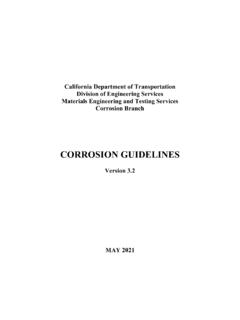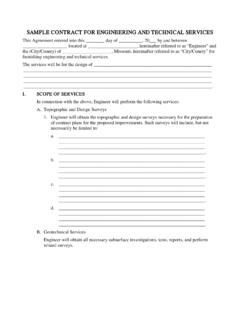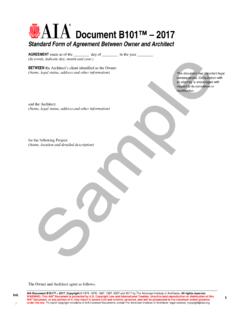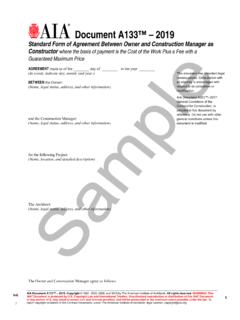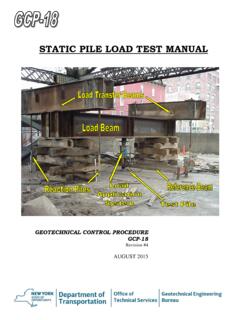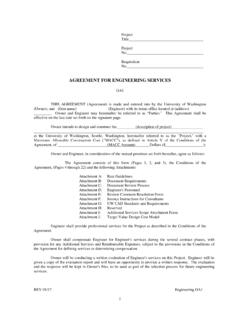Transcription of ATC-40 Seismic Evaluation and Retrofit of Concrete …
1 ATC-40 Seismic Evaluation and Retrofit of Concrete Buildings Volume 1 by APPLIED TECHNOLOGY COUNCIL 555 Twin Dolphin Drive, Suite 550 Redwood City, California 94065 Funded by Seismic SAFETY COMMISSION State of California Products and of the Proposition 122 Seismic Retrofit Practices Improvement Program PRINCIPAL INVESTIGATOR Craig D. Comartin CO-PRINCIPAL INVESTIGATOR PROJECT DIRECTOR Richard W. Niewiarowski SENIOR ADVISOR Christopher Rojahn Report No. SSC 96-01 November 1996 iii Preface Proposition 122 passed by California s voters in 1990, created the Earthquake Safety and Public Buildings Rehabilitation Fund of 1990, sup-ported by a $300 million general obligation bond program for the Seismic Retrofit of state and local government buildings. As a part of the program, Proposition 122 authorizes the California Seismic Safety Commission (CSSC) to use up to 1% of the proceeds of the bonds, or approximately $3 million, to carry out a range of activities that will capitalize on the Seismic Retrofit experience in the private sector to im-prove Seismic Retrofit practices for government buildings.
2 The purpose of California s Proposi-tion 122 research and development program is to develop state-of-the-practice recommenda-tions to address current needs for Seismic retro-fit provisions and Seismic risk decision tools. It is focused specifically on vulnerable Concrete structures consistent with the types of Concrete buildings that make up a significant portion of California s state and local government inven-tories. In 1994, as part of the Proposition 122 Seismic Retrofit Practices Improvement Program, the Commission awarded the Applied Technology Council (ATC) a contract to develop a recom-mended methodology and commentary for the Seismic Evaluation and Retrofit of existing con-crete buildings (Product ). In 1995 the Commission awarded a second, related contract to ATC to expand the Product effort to in-clude effects of foundations on the Seismic per-formance of existing Concrete buildings (Prod-uct ). The results of the two projects have been combined and are presented in this ATC-40 Report (also known as SSC-96-01).
3 Two other reports recently published by the California Seismic Safety Commission, the Provisional Commentary for Seismic Retrofit (1994) and the Review of Seismic Research Re-sults on Existing Buildings (1994), are Products and of the Proposition 122 Program, re-spectively. These two previous reports provide the primary basis for the development of the recommended methodology and commentary contained in this document. This document is organized into two volumes. Volume One contains the main body of the Evaluation and Retrofit methodology, presented in 13 chapters, with a glossary and a list of ref-erences. This volume contains all of the parts of the document required for the Evaluation and Retrofit of buildings. Volume Two consists of Appendices containing supporting materials related to the methodology: four example build-ing case study reports, a cost effectiveness study related to the four building studies, and a review of research on the effects of foundation conditions on the Seismic performance of con-crete buildings.
4 This report was prepared under the direction of ATC Senior Consultant Craig Comartin, who served as Principal Investigator, and Richard W. Niewiarowski, who served as Co-Principal Investigator and Project Director. Fred Turner served as CSSC Project Manager. Overview and guidance were provided by the Proposition 122 Oversight Panel consisting of Frederick M. Herman (Chair), Richard Conrad, Ross Cran-mer, Wilfred Iwan, Roy Johnston, Frank McClure, Gary McGavin, Joel McRonald, Jo-seph P. Nicoletti, Stanley Scott, and Lowell Shields. The Product methodology and commentary were prepared by Sigmund A. Freeman, Ronald O. Hamburger, William T. Holmes, Charles Kircher, Jack P. Moehle, Thomas A. Sabol, and Nabih Youssef (Product Senior Advisory Panel). The Product Geotechnical/Structural Working Group con-sisted of Sunil Gupta, Geoffrey Martin, Mar-shall Lew, and Lelio Mejia. William T. Holmes, Yoshi Moriwaki, Maurice Power and Nabih Youssef served on the Product Senior Advisory Panel.
5 Gregory P. Luth and Tom H. Hale, respectively, served as the Quality Assur-ance Consultant and the Cost Effectiveness Study Consultant. Wendy Rule served as Tech-nical Editor, and Gail Hynes Shea served as Publications Consultant. Richard McCarthy CSSC Executive Director Christopher Rojahn ATC Executive Director & ATC-40 Senior AdvisorTable of Contents vii Seismic Evaluation and Retrofit of Concrete Buildings Products and of the Proposition 122 Seismic Retrofit Practices Improvement Program Table of Contents Volume 1 Glossary .. xi Executive Summary .. xv Chapter 1 Introduction .. 1-1 Purpose .. 1-1 Scope .. 1-2 Organization and 1-5 Chapter 2 2-1 Introduction .. 2-1 Changes in 2-3 Getting 2-6 Basic Evaluation and Retrofit Strategy ..2-11 Evaluation and Retrofit Final Design and Chapter 3 Performance Objectives .. 3-1 Introduction .. 3-1 Performance 3-1 Earthquake Ground Motion.
6 3-8 Performance Objectives .. 3-9 Assignment of Performance Objectives ..3-12 Chapter 4 Seismic 4-1 Scope .. 4-1 Earthquake Ground Shaking Hazard Levels .. 4-1 Ground Failure .. 4-2 Primary Ground Shaking Criteria .. 4-5 Specification of Supplementary Chapter 5 Determination of Deficiencies .. 5-1 Introduction .. 5-1 Seismic Evaluation AND Retrofit OF Concrete BUILDINGS viii Table of Contents Description: Typical Layouts and 5-1 Seismic Performance .. 5-5 Data Collection .. 5-12 Review of Seismic Hazard .. 5-17 Identification of Potential Deficiencies .. 5-18 Preliminary Evaluation of Anticipated Seismic 5-20 Preliminary Evaluation Conclusions and 5-21 Chapter 6 Retrofit Strategies .. 6-1 Introduction .. 6-1 Alternative Retrofit Strategies .. 6-4 Design Constraints and 6-24 Strategy Selection.
7 6-27 Preliminary Design .. 6-30 Chapter 7 Quality Assurance 7-1 General .. 7-1 Peer Review .. 7-2 Plan Check .. 7-8 Construction Quality Assurance .. 7-10 Chapter 8 Nonlinear Static Analysis Procedures .. 8-1 Introduction .. 8-1 Methods to Perform Simplified Nonlinear Analysis .. 8-3 Illustrative Example .. 8-34 Other Analysis Methods .. 8-54 Basics of Structural Dynamics .. 8-57 Chapter 9 Modeling Rules .. 9-1 General .. 9-1 9-2 Global Building 9-4 Element Models .. 9-7 Component Models .. 9-19 Notations .. 9-46 Chapter 10 Foundation Effects .. 10-1 General .. 10-1 Foundation System and Global Structural Model .. 10-2 Foundation Elements .. 10-7 Properties of Geotechnical Components .. 10-12 Characterization of Site Soils .. 10-20 Response Limits and Acceptability Criteria.
8 10-28 Modifications to Foundation 10-29 Chapter 11 Response Limits .. 11-1 General .. 11-1 Descriptive Limits of Expected Performance .. 11-2 Global Building Acceptability Limits .. 11-2 Element and Component Acceptability Limits .. 11-5 Seismic Evaluation AND Retrofit OF Concrete BUILDINGS Table of Contents ix Chapter 12 Nonstructural Components ..12-1 Introduction ..12-1 Acceptability Chapter 13 Conclusions and Future Directions ..13-1 Introduction ..13-1 Additional Potential Major Challenges ..13-5 Recommended Action Plan ..13-6 References ..14-1 Volume 2 Appendices Appendix A Escondido Village Midrise, Stanford, Appendix B Barrington Medical Center, Los Angeles, B-1 Appendix C Administration Building, California State University at Northridge, Northridge, California ..C-1 Appendix D Holiday Inn, Van Nuys, California.
9 D-1 Appendix E Cost Effectiveness Study .. E-1 Appendix F Supplemental Information on Foundation Effects .. F-1 Appendix G Applied Technology Council Projects and Report Information ..G-1


